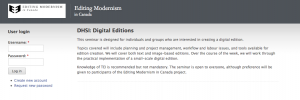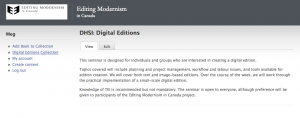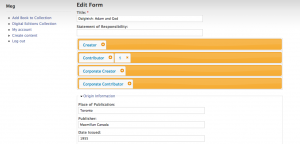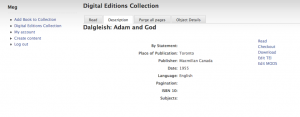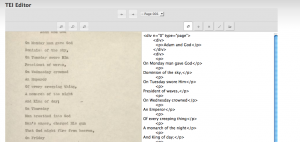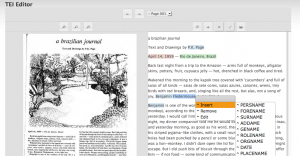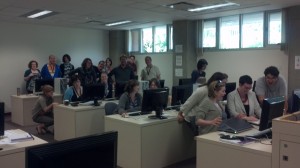Archives
Archive for the ‘Technology’ Category
August 11, 2011
TEMiC – Week 2, Day 4: Energy and Inspiration
This morning’s work can easily be summarized with one word: energy. Our session began with Melissa Dalgleish’s discussion of her current work involving the digitization of the collections of Anne Wilkinson. As part of her discussion, Melissa gave a demonstration of an alpha version of her digital interface. I was not alone in being impressed with the elegant, clean, and extensible qualities of the few pages she demonstrated. She also addressed some of the challenges she faces, such as how she intends to label her project (since “archive” and “edition” seem to be misnomers, and “collection” and “collected” both seem insufficient), how she plans to prioritize and organize her data (at which point Melissa re-iterated her principle of modularity; that is, to work with smaller projects that can be incorporated into a larger architecture), and what to do with the vast raw material she has at her disposal.
From Melissa’s engaging talk, our group quickly branched out into a larger discussion of the issues and complexities surrounding digital humanities. Matt Huculak, Dean Irvine, and Zailig Pollock all contributed their vast expertise to the conversation. Zailig highlighted the opportunities stemming from digital representation of original manuscripts, and specifically offered kind words for Melissa’s project and her rationale. Matt stressed the importance of working with reproductions of your original files, while Dean encouraged us to re-consider how we manage our workflow, asking us to take a scientific approach and to offload raw data onto databases, rather than rely on our own machines for data storage. Extending this line of thinking, Dean talked about SourceForge and GitHub, two portals for dissemination of and collaboration with beta versions of software. He reminded us of the importance of sharing our groundwork, so that future scholars needn’t re-invent the wheel every time we begin a new markup project. He pointed to a number of resources, including Juxta, the Versioning Machine, and a proof-of-concept transparency viewer at MITH.
We also talked about the culture surrounding academic work and the spirit of collaboration that typifies the EMiC experience. During the conversation, we all agreed that there is very much a feeling of ‘stumbling around in the dark’ in regards to digital humanities scholarship, which could be remedied (or at least addressed) by further collaboration. However, we also acknowledged that many scholars involved in EMiC already have ample demands upon their time and resources. We brainstormed the possibility of some form of EMiC mentorship program, wherein an experienced scholar or researcher could be asked to mentor a new member of the EMiC community. In this scenario, new members would not only learn the skills already acquired by more senior EMiC community members, but also benefit from the comfort of knowing that it is alright (and normal!) not to start from a position of expertise; indeed, that EMiC’s membership comprises all sorts of skill levels and competencies.
Our afternoon was a lot more free-wheeling. The session opened with a discussion of the idea of co-authorship, and Deans’ sketches for a plan for establishing standards, again drawing upon the scientific model for inspiration. Zailig then talked specifically about his experiences on his various editorial projects, and how he operated as a member of an editorial board, and his views on the role of junior scholars on these boards. He then discussed some other editorial projects, citing what he felt worked well and what didn’t.
Dean then postulated the creation of an EMiC Editions in order to avoid the label of EMiC projects becoming “coterie publications.” He suggested implementing a peer-review process in order to lend more credence to the work produced by EMiC scholars. However, since over a hundred researchers are now involved in EMiC across Canada, he realizes that arms-length peer-review becomes difficult. He suggested that EMiC might need to cultivate relationships with other Modernist organizations, specifically in the United States (although I imagine he would extend his vision globally as well). This, he believes, will foster a greater level of respectability for EMiC, cultivate a common vocabulary for assessment, and create a de-centred model for digital humanities scholarship. In the process of introducing this idea, Dean talked a bit about the history of EMiC, how it has developed as a network and the ways it has evolved since its inception.
Finally, Dean talked about how to fund our research projects. He spoke at length about the idea of leveraging the resources already at our disposal, such as cultural capital and organizational affiliations, and how to use these (and many, many other) resources to succeed in securing funding.
We covered a lot of ground in the afternoon, and I found my mind bouncing from topic to topic. Not that I wasn’t interested in our conversation: in fact, the opposite was true! Again and again, I was jotting down all kinds of notes, half-formed ideas, twists, turns and re-imaginings I might want to incorporate into my own research – and all from the discussion that was generated today! It was fantastic to share the air with EMiC’s zeitgeist incarnate. Dean’s vitality is infectious, and the enthusiasm he imparts, coupled with Zailig’s immense experience and knowledge, and Matt’s incredible expertise, has me feeling inspired, energized, and eager to dive into my research!
Suffice to say, our morning energy carried through to the end of the day, and is likely to carry me forward as I make my way back to New Brunswick at the end of the week, and beyond…
August 9, 2011
Day 2, Week 2 of TEMiC: Project Planning and so on…
For day two of Textual Editing Modernism in Canada (TEMiC) our discussions focused on planning both Digital and Print editorial projects. Because we are all at different stages in our projects (or yet to be determined projects) we tried to approach the subject as broadly as possible, sharing and elaborating at points of interests for all. For the sake of simplicity I am going to break the day into three sections (excluding lunch, though our conversations at lunch are often fruitful) and provide a snapshot of what we covered at each point in the day.
Preface:
We had some exciting news to start off the day. Apparently, Zailig Pollock’s grandchild has been potty trained. All it took were a few M&M’s. Exciting, no?
Part 1: Sage Advice from Zailig Pollock
First, I would like to express my sincere gratitude to Dr. Zailig Pollock whose advice has been invaluable to our discussions. His experience has provided me (and others, I am sure) with a unique and informed perspective on textual editing. My thinking has advanced exponentially in the past week and two days.
Our morning focused on the question “How should we approach editing projects?” And so we spent the morning creating a road map to begin to answer this question.
1. Choosing your institution: Its always important to find an institution with scholars who would be interested (or sympathetic) to your work. If you want to work on a digital editing project, you should try to find an institution with a potential supervisor/advisor who is interested in the Digital Humanities (DH). The same rule applies to Non-DH editing projects.
2. Choosing the author or group you would like to focus on: Try to choose an author or body of work you can justify editing, but also an author/work you are genuinely interested in.
3. Figure out where your material is located: It might be necessary to carry out extensive archival work. Being near (or far) from your material can have a dramatic impact on your work.
4. Permissions: Permissions can be tricky to acquire. Find out who holds the rights to the work, and be sure to consider issues such as privacy and ethics that may crop up.
5. Get to know your body of work: An editing project should be informed by the body of work and the work surrounding the body.
6. Theorizing your project: Decide on the methodolog(ies)y you wish to employ for your project. Deciding this early will help determine the work you do on the text and also shape the output.
After you theorize your project there are many different avenues you can take. The list above is a basic approach and of course there many variations.
Our conversations also stressed the importance of building realistic timelines and carefully considering the amount of work we take on. In addition, we discussed the complicated task of gaining permissions. Potentially stellar projects can be quashed if an editor is denied access or rights to the material. Many factors need to be considered by the editor(s) and those who hold the rights. Factors that can influence these issues include finances, competition, privacy, image control and more.
Part 2: Guest Speaker, Carole Gerson
In the afternoon we were visited by the esteemed and experienced Dr. Carole Gerson. Gerson’s work focuses primarily on early Canadian literature and Canadian book history. She has edited a number of volumes including Pauline Johnson: Paddling Her Own Canoe: The Times and Texts of E. Pauline Johnson (Tekahionwake) (2000) and E. Pauline Johnson, Tekahionwake: Collected Poems and Selected Prose (2002). Gerson’s talk consisted mainly of anecdotes. She focused not only on her successes as an editor, but also the issues she has faced over her career. These issues ranged from typos, reprints, and problems of design to lack of information access at crucial moments. A discussion of these issues was especially useful because we were able to see what we may be faced with in the future.
Part 3: Image Markup Tool
We spent the remainder of the afternoon looking at the work Zailig Pollock has been doing on The Digital Page with the Image Markup Tool (IMT). For those of you unfamiliar with the markup tool… IMT is a unique and simple tool which allows editors to focus (or tag) interesting points of a document. It is especially useful for annotating, marking up, and noting revisions in materials. One simply scans the image in and then uses IMT to tag the desired space (its a lot like tagging a friend in a photo on facebook). IMT is an extremely valuable and exciting tool because it allows the viewer to get as close to the document as possible without having to go to the archive (a trip we should encourage).
After the IMT tutorial we knocked off for the day. We covered a great deal of ground and I think we all have a better idea of the work we face and the options that are available to us as we proceed.
I’d like to cap this post with a photo of a small token I received from Zailig. The image below presents a worm-cast that he found in Prince Edward Island. What weird and relevant artefact!
“and many and many
come up atom by atom
in the worm-casts of Europe.”
– from “I’ve Tasted My Blood” by Milton Acorn
It seems I have concluded this post the way it has been prefaced…
July 2, 2011
Two Steps Toward Digital Editions of Wyndham Lewis’s Canadian Works
Wyndham Lewis—the Canadian-born modernist painter, writer, critic, pamphleteer, etc.—is undergoing something of a renaissance at the moment. Two examples should suffice to make the point: Lewis’s work is the highlight of a major Vorticist exhibition at the Tate Britain this summer; and his first (and, to my mind, best) novel, Tarr, has recently been issued in the Oxford World’s Classics. That this renewed attention should be focused on his earliest work, however, is indicative of a lamentable tendency to concentrate on Lewis’s early activities as an avant-garde provocateur and to ignore a fascinating period of his later career—one of central interest to the study of Canadian modernism: the time he spent in Canada during the second world war.
Lewis spent the entirety of the period 1939-1945 in North America, living mostly in Toronto and Windsor. He published one book in Canada—Anglosaxony: A League That Works (Ryerson Press, 1941)—and planned another, which he published on his return to England, America and Cosmic Man (1948). Both books demonstrate an important shift in Lewis’s political thought, from the strongly-advocated nationalism of the early to mid thirties towards an equally adamant espousal of internationalism. In Anglosaxony, Lewis praises the “flexible,” “non-absolutist,” and “rootless” character of North American citizenship (29). He develops this in America and Cosmic Man, where he describes North America as “a laboratory for the manufacture of Cosmic Man” (201-2), the “perfectly eclectic, non-national, internationally-minded creature” (203) he takes as his ideal citizen.
Neither of these works has received the attention it deserves. The case is particularly acute for Anglosaxony, which Thomas Dilworth describes in The Talented Intruder as “virtually unobtainable” (159). The book was printed in a tiny edition in 1941, which sold so poorly that the majority of copies were pulped. Lewis produced a revised edition in 1941, in which he attempted to reflect the rapidly-changing political situation. Because of the poor sales of the first edition, however, it was never printed (the manuscript is available in PDF format, however, on the website of the Wyndham Lewis Society.)
It was with a view to remedying this situation that I attended DEMiC at the Digital Humanities Summer Institute in early June. I participated in the Text Encoding Fundamentals class, where my goals were (1) to learn the TEI encoding procedures by which I could make the first edition of Anglosaxony available in a digital edition and (2) to learn more advanced coding techniques that would allow for the production of an edition reflecting Lewis’s unpublished revisions to this first edition. With much help from my instructors and classmates, I now have the encoding knowledge that will eventually allow the reader of a digital Anglosaxony to view the text in its original 1941 edition, to see it as it would have appeared in a revised second edition, or to see a version that registers the differences between the two editions.
Anglosaxony and America and Cosmic Man demonstrate the extent to which Lewis was influenced by his period of residence in North America—their celebration of multiculturalism and internationalism result directly from is observations of life in Canada and the United States. But they do not register the enormous influence that Lewis exerted on Canada—in particular, on the development of Canadian Modernism. Scholarship is only beginning to explore the full scope of this influence. In The Talented Intruder, Thomas Dilworth provocatively claims, “[b]y crossing the Atlantic in 1939, Lewis brought Canada into the history of literary modernism” (157). In his forthcoming Avant-Garde Canadian Literature: The Early Manifestations, Gregory Betts of Brock University devotes a chapter to what he calls the “Canadian Vorticists,” a community of Lewis-inspired Canadian modernists that includes such influential figures as Marshall McLuhan, Sheila Watson, and Wilfred Watson.
I began to sketch the outlines of Lewis’s relationship with Canada in an article for The Walrus in October 2010. A few weeks ago—in late June—I pursued my research by presenting on an EMiC-sponsored panel devoted to Sheila Watson and Marshall McLuhan at the 2011 convention of the Media Ecology Association at the University of Alberta in Edmonton. This panel, organized by Paul Hjartarson and Kristin Fast of U of A, gave me an opportunity to advance my argument that Sheila Watson (who wrote her dissertation on Lewis) and Marshall McLuhan (a friend of Lewis’s in Windsor who drew heavily on Lewis’s work) should be regarded as Lewis’s “ideal readers”: that they were not merely influenced by Lewis, but were able to extract the best from his style and ideas, and thus to turn him into an influence on Canadian letters and society.
The conference also put me in touch with a network of scholars who are actively exploring the importance of Lewis’s Canadian works to the development of Canadian Modernism. A fascinating paper by Elena Lamberti of the University of Bologna discussed the links between Lewis’s America and Cosmic Man and McLuhan’s 1954 Counterblast (itself a response to Lewis’s 1914 Blast.) At another EMiC-sponsored panel on the relationship between McLuhan and Wilfred Watson (who once began a dramatic adaptation of Lewis’s The Apes of God), Gregory Betts of Brock dealt extensively with America and Cosmic Man and presented a number of illuminating connections with McLuhan’s ideas. In a post-conference workshop, I was able to discuss my work with Linda Morra of Bishop’s, Paul Tiessen of Wilfred Laurier, and Wayne DeFehr of the University of Alberta—the other presenters at the EMiC-sponsored panels—who provided me with numerous leads to pursue in my work on the influence of Lewis’s Canadian texts. I’m pleased to say that I will be collaborating with this group of scholars on a book that will explore the network of influence between Sheila Watson, Wilfred Watson, and Marshall McLuhan in the context of Canadian Modernism. I’m even more pleased to say that this group has understood the crucial role of Wyndham Lewis in this network, and that the book will contribute to promoting understanding of this fascinating relationship.
It was a wonderfully productive June, in which I took major steps in my research: first learning the fundamentals of text encoding at DEMiC that will allow me to make Anglosaxony available to the growing community of scholars interested in Lewis’s Canadian works; and second attending the EMiC-sponsored panels at the Media Ecology Association’s 2011 conference, and discussing my ideas with prominent members of this very community. I owe enormous thanks to the Editing Modernism in Canada project for both.
Adam Hammond, University of Toronto
June 12, 2011
Digital Editions @ DHSI: 2011 Version
This past week, I had the opportunity to teach a course on digital editions at the Digital Humanities Summer Institute with Matt Bouchard and Alan Stanley. It was my first time as an instructor at DHSI, and I was filled with nervous excitement on Monday morning. What I wanted to do with the course this year was to offer a holistic approach to building a digital edition that challenged the participants to think about their projects not only as a whole, but also as iterative and modular. The two themes that I tried to highlight were the importance of project management and the user-experience design. We talked quite a bit about planning and project management, workflow, information architecture, and for the first time, we worked with the alpha version of the Islandora editing toolkit.
All in all, I think the course went very well! Below are some of the highlights. I’ve included my classroom slides and handouts in the hopes that these materials will be useful for those who were unable to attend the course and who may be beginning to think about building a digital edition, and for anyone who is interested in what we were up to this week!
Day 1 Overview
On the first day we began with an overview of print editions, and talked a little bit about some of the benefits of text-based versus image-based digital editions. The class came up with quite a substantial list of the elements that comprise a print edition, including:
timlines/chronology
glossary
static pages
page numbers
running headers
marginalia
provenance
book cover
dust jacket
reviews
bindings
bibliographies
biographies (author, editor)
table of contents
footnotes
endnotes
critical introduction
appendices (contextual, editorial)
errata strips
publisher information
typography/font
stitching/glue
whitespace, gutters
watermark
end papers
title pages
section pages
copyright
images (photos, illustrations)
dedications
acknowledgments
I encouraged students to think about these elements as they began to to conceptualize their digital editions. Many or all of these features might need to be included in a digital edition, and the challenge was to think about how we might represent them digitally. I also gave a very brief introduction to some of the current tools and platforms available for building digital editions. In the afternoon, we worked through a “Site Audit” of some existing digital editions, and considered what worked (and what didn’t) in the digital editions that are currently available.
Slides for day 1:
Day 2 Overview
On day two, we focused on project management. Borrowing heavily from Jeremy Bogg‘s work, I talked about the importance of thinking of the project in terms of different phases. Then I introduced the ever-so-important “Scope Document”, and asked the students to spend some time conceptualizing their project(s) as a whole. I suggested that before beginning to implement (read: code) a digital project, one must consider the project from multiple perspectives and have a rock-solid scope document and technical / feature specification in place. Building a project in phases allows for an iterative process that keeps the project moving forward, without the too-often paralysis that faces digital humanities projects that suffer from scope creep (or, more often, scope explosion). Instead of starting to code an entire collected works, I argued, try starting with a small subset that can serve as a robust working model for the project as whole.
I provided a handout with a long list of questions to ask at each stage of the project. These questions are meant to serve as a guide for project planning (and, if you so choose, a grant application).
Phase 1: Strategy / Project Objectives
- What kind of edition are you creating? Why?
- Why is your project important?
- What’s already available?
- Who is your audience?
- What are the limitations of your project?
- What approach or methodology will the project follow?
- What are the major dates or milestones for key points?
- How will you determine whether your project has been successful?
Phase 2: Scope
- What features would you like to include in your edition?
- What tools and technologies will you use (Islandora/Drupal, Image Markup Tool, Simile Timeline, JUXTA)?
- What kinds of questions can you ask of your data using text analysis and data visualizations? (This will impact the platform and technology you choose)
- Do you have technical skills or will you be working with a developer?
- Who will be involved in the project, and what will their responsibilities be?
- What specific components are needed on the site? What technologies? Static HTML? Need dynamic content? Need a CMS? Need a custom web application or interactive features?
- What tools would you like your project to be compatible with? Is there a specific data format you will need to use?
Phase 3: Content
- Create a sitemap that will determine how content is categorized and contained within the overall structure of the site
- Inventory of content: what will you put on each page? In each section?
- What kinds of materials are you using? General description? File formats?
- What is the relationship among different pages, images, texts, tags, categories, etc?
- How will users interact with your content? (Search, manipulation, view?)
Phase 4: Design
- What do you want to communicate?
- What do you want users to remember?
- How do you want users to respond?
- What are some “benchmark” editions that might influence your design process? (Site Audit)
- What do you like about these designs? Why?
Slides for day 2:
Day 3 Overview
On Wednesday, we moved into some hands-on technical work, and had the opportunity to begin using the Islandora editing system for the first time. Islandora is an editing workflow that integrates a Fedora Commons backend with a Drupal front-end. EMiC is working in partnership with the great folks at UPEI to create a fully-functional editing toolkit that allows users to pull materials from the commons (housed in the Fedora repository) and edit them in a web-based environment. Alan Stanley was an invaluable asset, and the testing and editing process would not have run as smoothly as it did without his help on the ground. It seemed like every time we found a bug, Alan was able to step in and fix it almost immediately.
Here are a few screenshots of the system:
The login screen and home menu:
MODS metadata editing for a Book object:
Object Description page:
TEI Editor:
Image Markup Tool Integration:
The participants in the digital editions class showed remarkable patience and understanding working with a tool that, at its core, is still in alpha phase (pre-alpha, even). Thanks to everyone in the class for serving as the first user-testers for the Islandora editing suite. At times, I’m sure you felt more like bug hunters than editors, but please know that your feedback will be invaluable in the development of the EMiC/Islandora editing workflow. Kudos!
Day 4 Overview
Once we’d had a chance to work with some of the technical aspects of editing a digital edition, we took a step back and talked a bit about design. I argued that design is visual rhetoric, and that as editors, it is as important to think about aesthetics as it is to consider content. In fact, I would go so far as to say that in building digital editions, form and content are inseparable. Good design, built with the user-experience in mind, often means the difference between a usable and unusable tool. On the afternoon of day four, participants worked on various aspects of their projects, depending on what they deemed most important to them.
Slides for Day 4
Day 5 Overview
On Friday morning, each person in the class gave a brief presentation of their projects and what they learned this during the course. I think Yoshiko’s slide captures the week quite aptly:
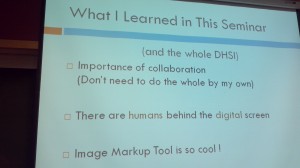
Over the course of the week, the students worked through site audits and project scope documents, design specifications, user personas, and wireframes for their digital projects. We talked a lot about designing for the user experience and the importance of bringing together form and content. “Modularity” was certainly the word for the week, and I hope that the students left with a solid understanding of all of the various pieces (and people) that are part of the process of creating a digital edition. Thanks to all of the participants for your generosity, patience, engagement, and brilliance. I had a fabulous week, and I hope you did too!
June 7, 2011
DHSI=>DEMiC=>Digital Editions
At our DEMiC 2011 orientation session, I had a chance to welcome 30 EMiC participants to the Digital Humanities Summer Institute at the University of Victoria. Or, rather, 31 including myself. A long month of EMiCites. This is our largest contingent so far, and DHSI itself has grown to host over 200 participants attending 10 different courses. The EMiC community is represented at DEMiC by 13 partner institutions. EMiC has people enrolled in 7 of the 10 offered courses. But what really makes DEMiC 2011 different from previous years is that EMiC is offering its own DHSI course.
If you’re already dizzied by the acronyms, this is how I parse them: DHSI is the institute in its entirety, and DEMiC is our project’s digital training initiative that allows our participants to take any of the institute’s course offerings. With the introduction of EMiC’s own course, DEMiC has transformed itself. EMiC’s Digital Editions course draws upon the specializations of multiple DHSI course offerings, from Text Encoding Fundamentals to Issues in Large Project Management.
The course has been in the making for roughly six years, beginning with the pilot course in editing and publishing that Meagan and I first offered at Dalhousie in 2006-07. This course was not offered as part of my home department’s standard curriculum, which actually proved advantageous because it gave us the freedom to develop an experiential-learning class without harbouring anxieties about how to make the work of editing in print and digital media align with a traditional literary-studies environment. In other words, we started to develop a new kind of pedagogy for the university classroom in line with the kinds of training that takes place at digital-humanities workshops, seminars, and institutes. To put it even more plainly: we wanted to import pieces of DHSI to the Maritimes. That was pre-EMiC.
With EMiC’s start-up in 2008, we began flying out faculty, students, and postdocs to DHSI. After two years (2009, 2010) of taking various DH courses at introductory, intermediate, and advanced levels, we consulted with the EMiC participants to initiate the process of designing our own DHSI course. Meagan and I worked together on the curriculum, and Matt Huculak consulted with both of us as he surveyed the various options available to us to serve as an interface and repository for the production of EMiC digital editions at DHSI. After six months of trial and error, weekly skype meetings with about a dozen different collaborators, three different servers, and two virtual machines, we installed Islandora with its book ingest solution pack. That’s what we’re testing out in Digital Editions, keeping detailed logs of error messages and bugs.
I would like to thank the many people and institutional partners who have come together to make possible the first version of Digital Editions. This course is the product of an extensive collaborative network: Mark Leggott’s Islandora team at the University of Prince Edward Island (Alan Stanley, Alexander O’Neill, Kirsta Stapelfeldt, Joe Veladium, and Donald Moses), Susan Brown’s CWRCers at the University of Alberta (Peter Binkley, Mariana Paredes, and Jeff Antoniuk), Paul Hjartarson’s EMiC group at the UofA (Harvey Quamen and Matt Bouchard), EMiC postdoc Meagan Timney at UVic’s Electronic Textual Cultures Lab, Image Markup Tool developer Martin Holmes at UVic’s Humanities Computing and Media Centre, and EMiC postdoc Matt Huculak at Dalhousie.
As I write this at the back of a computer lab at UVic, fifteen EMiC participants enrolled in Digital Editions are listening to Meagan, Matt Bouchard, and Alan walk them through the Islandora workflow, filling out MODS forms, testing out the book ingest script with automated OCR, and editing transcriptions in the web-based TEI editor. Some people are waiting patiently for the server to process their ingested texts. We’re witnessing the first stages of EMiC digital editions of manifestos and magazines, poems and novels, letters and short stories. We ingested texts by Crawley, Livesay, Garner, Smart, Page, Scott, Sui Sin Far, Watson, and Wilkinson. And we’re working alongside an international community, too: our newly born repository is also populated with editions of D.G. Rossetti, Marianne Moore, Tato Riviera, Hope Mirrlees, Catherine Sedgwick, and James Joyce.
This afternoon the server at UPEI processed 20 different texts. Hello world. Welcome to Day 1 of the EMiC Commons.
April 14, 2011
Reading between the lines: The Crawley and Livesay archives
Over the past few days I’ve been ensconced in the Queen’s University archives, looking at the papers of Alan Crawley and Dorothy Livesay for my EMiC edition. This is a volume of correspondence between various figures involved in modernism – authors, critics, editors – with the working title Enduring Traces: Correspondence from Canadian Modernism’s Archives.
Working in the archive can
be a peculiarly seductive pleasure: no need to rehearse Derrida’s admonition about its “conservative production of memory” to a crowd who also no doubt feels the pull of the archive’s promise to clarify literary history, to pin down what really happened once and for all. Fortunately, reminders are constantly to hand about the contingency of the stories it tells. Livesay, for example, writes the script of a portrait of Crawley for broadcast on the CBC, which begins by calling attention to his blindness. Crawley writes to her, mentioning that he is uncomfortable with this emphasis, and asking for some other changes. From Livesay’s other drafts it’s clear that she revised the document based on his wishes. A print version of this portrait is then rejected by Maclean’s because it does not contain enough “lively anecdotes illustrating the character of Mr. Crawley”. This sequence of documents offers a tiny glimpse of some of the pressures Livesay was under as she put together a narrative about Crawley’s contribution to Canadian poetry (and this is to say nothing of the intriguing ways she narrativises various other aspects of the story of the founding of Contemporary Verse, such as eliding the gender of the poets who suggested him as editor).
Crawley’s letters also present some interesting editorial conundrums (conundra?) which have led me to reflect on the materiality of the technology he was using to write them. Some of the letters were typed by him, while others have been typed by his wife, Jean, and those typed by Crawley have the occasional line break in unexpected places. Wondering whether to reproduce these idiosyncratic line breaks, I found myself coming up with all sorts of hypotheses about what might have led him to make them, which I suddenly realised were all dependent on having actually used one of these clunky manual typewriters myself as a kid. (And no, I’m not that old – this thing was a dinosaur even back in the 80s, when other families were splurging on such sleek and speedy creatures as Apple IIes). While a sighted typist would have been able to see how much space remained until the end of the line, Crawley would only have had the aural reminder of the typewriter’s bell a few spaces from the end of the line, and his own memory of how long the line had gone on (something which it would be easy to lose track of if one paused to think in the middle of a line) to tell him when to hit the carriage return. Perhaps, I wondered, if he paused mid-line and forgot whether the bell had gone, it was simply easier to start a new line, which is something different to the intention to start a new paragraph.
My reasoning may well be wrong here, but one thing’s for sure: I’ve gained a fresh appreciation for that ugly old typewriter. It’s one thing to hear the ding of a typewriter’s bell and to see its carriage return being used to move the paper down in the background of a scene from Mad Men; it’s quite another to have actually had to wrangle one of these machines yourself, and to know how the carriage return could not be relied on to produce perfectly even gaps between all the lines. Will editors in fifty years’ time find themselves needing this kind of knowledge about the vagaries of auto-correct on iPhone keypads, and haptic feedback on tablet computers?
March 9, 2011
Editing Page
I have just submitted my report on a very valuable experience supervising Emliy Ballantyne as my research assistant in the Digital Page project, so I thought it might be appropriate to say a few words about thoughts and feelings that arose as I was doing so.
I have been involved in textual editing for about 30 years now, and there is no doubt in my mind that the project I am currently involved in, a digital edition of the Collected Works of P.K. Page, is the most exciting of my career, to a large extend owing to the support of EMiC. EMiC has, of course, provided much desired funding for the project — the RAship is a case in point — but much more important is the sense of community it has fostered, through institutes, conferences, this web site, and also by generating an exciting buzz in the world of scholarly editing in Canada that has simply not been there before. At Trent we are particularly fortunate to have several faculty members involved in editing various volumes of the Collected Works as well as a group of outstanding students enrolled in our Public Texts MA program and a recently announced SSHRC postdoc — congratulations to Michele Rackham! The lonely task of the textual editor has never seemed less lonely. I have been particularly inspired and moved by the many gifted and accomplished young people who have been attending DEMiC in Victoria and TEMiC in Trent, as well as the recent conference on Editorial Problems in Toronto, and it has been a real privilege to have been involved in teaching TEMiC along with Dean. When EMiC has run its course, part of its legacy, I am sure, will be a body of texts edited to the highest possible scholarly standards. But equally important will be a community of scholars at all stages of development who will have done great work together and will continue to do and to inspire great work in the future. Sorry if this comes across as a gush, but it is a gush from the heart. In future blogs I will be much more technological and theoretical and philosophical, but I did want to testify to how important EMiC has been to me.
February 15, 2011
Website Maintenance, 16 Feb. 2011, 7-9pm EST
The EMiC website will be undergoing some scheduled maintenance on 16 Feb. 2011 from 7-9pm EST. During that time you will be unable to access the site. Apologies in advance for the inconvenience.
January 20, 2011
In Search of a Digital Humanities Repository
Before I became the newest EMiC Postdoctoral Fellow this past fall, I regularly discussed with my colleagues the lack of a simple editing and publication engine for Digital Humanities scholars and teachers. My field of research, modernist Periodical Studies, is rapidly expanding, and the digital environment promises new ways of archiving and accessing magazines that have been scattered across university libraries around the world. Organizations like the Modernist Journals Project are doing wonders in delivering complete digital editions of periodicals to scholars, but there is no place a professor can go to teach a student how to digitize, OCR (Optical Character Recognition), markup, and publish a magazine or book for a class project. This was a major problem for David Earle at the University of West Florida who was teaching an undergraduate section on modernist magazines and wanted his students to produce a digital edition at the end of the course. Earle realized that he had to negotiate a complex field of proprietary software and web expertise to make his course viable. With a bit of elbow grease, Earle started, with his students, “The Virtual Newsstand from the Summer of 1925.” His class was asked to help “recreate” a 1920s American newsstand—that is, what magazines and papers would the average New Yorker have seen in one of the little kiosks on a warm summer afternoon in 1925? As you can see, the project was a great success, and I hope it is something we can help our EMiC team do too in the classroom.
My primary task this term has been to set up the EMiC Digital Coop and Digital Commons. The Coop will be a closed repository where you will be able to upload everything you have scanned for the EMiC community. The Commons will be the place where you can publish your own digital editions. This will be a public space, so only material that is in the public domain, or material with which you have secured rights, may be published here. I’ve had two questions in mind: what type of system can we use that will be easy to use for the ingestion of material to the EMiC repository, and what system can we use to publish that material once it is ready? We also want to make sure that our repository uses the best open archival practices available to us today. This ensures that EMiC (your work and mine) will be compatible with other university systems and repositories for many years to come; for example, Susan Brown is in the process of creating the CWRC (Canadian Writing Research Collaboratory, or “quirk”), which promises to be one of the greatest archives in Canada once it goes online. Brown will be building the CWRC on the Fedora Commons framework at the University of Alberta, and thus it is important for EMiC to be able to create a repository that will work well with this future archive. To this end, we have decided to build our repository on the Fedora Commons framework as well.
Now that we have a framework, how do we create a system that is convenient and easy-to-use? This has proven to be a very difficult question. As many of you know, the Center for New Media and History at George Mason University has released a powerful publication and exhibition tool called Omeka. Though Omeka is a powerful tool (and it only promises to become even more powerful), it does not provide all the tools we need to run an agile and powerful repository. After much research, I came across Islandora, a content management system created at the University of Prince Edward Island built upon Drupal. Islandora provides us with an easy-to-use system that allows us to upload an image file and have an automated workflow create OCR, PDF and XML files (including TEI) upon ingestion. The team at PEI, including Mark Leggott, Donald Moses, Joe Velaidum, and Kirsta Staplefeldt are committed to building open tools for the digital humanities community at large (and they have a digitization lab to die for). We are very impressed with their scholarly model, and we hope that they will use their experience with EMiC to collaboratively build a repository specifically geared towards digital humanists (Islandora is already hard at work in museums and universities around the world).
But before we commit to a system, we need to run vigourous tests to make sure the system we build for EMiC will last long into the future. In order to ensure this, Dean Irvine has allocated funds for a study into Islandora and Omeka at the University of Alberta for EMiC use (and if all goes well, perhaps for the CWRC as well). By the end of January, EMiC should be able to announce our findings. Our goal is to provide a complete editing and publication engine not only for our community, but the world at large as well. How will this happen when we have great tools like TILE, Omeka, Islandora, which weren’t built specifically to work with one another?
As many of you know, Meagan Timney, the other Postdoctoral Fellow at EMiC, is a talented programmer and teacher committed to the Digital Humanities (and I’m told, she is also the person who championed the idea of EMiC before it was even a proposal in the Director’s eye). She has agreed to code the necessary APIs to allow our new system to work with Fedora Commons (and thus Islandora) and Omeka. Her work will provide the Digital Humanist community and important plugin so users of Omeka and Islandora will be able to edit images on the web and in the repository. For those of you attending DHSI this summer at the University of Victoria, she will be teaching a course on “Digital Editions” (http://editingmodernism.ca/training/summer-institutes/demic/) where students will get to use this new tool in creating their own digital work. I encourage you to sign up for her course if you would like to learn how to digitize, edit, and publish a text to the web.
So, where does this leave us? Well, we hope that by the end of spring someone like David Earle will never have to look for an editing and publication engine ever again. This also means that we will be ready to start ingesting the material you have all been scanning directly into the repository. We hope EMiC will provide our community with the archive and tools it needs to start producing the texts you want to create from your various archives. We are truly on the cusp of creating an entire framework that will help scholars around the world produce and edit texts that will be nurtured in an open-source and secure repository for many years to come.
November 19, 2010
EMiC and TILE: New Developments

Over the past few weeks, we’ve been in contact with Doug Reside at MITH, and are pleased to announce that EMiC and TILE have formed a partnership! Essentially what this means is that my time has been reallocated to the development and documentation of TILE, which is very exciting! This is just a preliminary announcement, and I’ll post more about this exciting venture soon!

